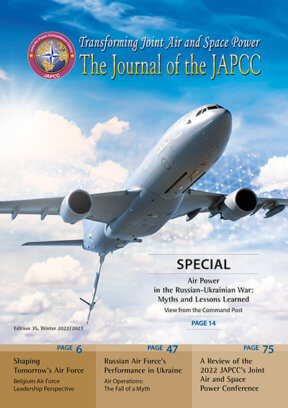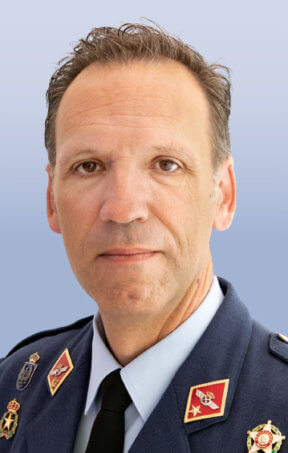Introduction
On 24 February 2022, the world witnessed outrage over Russian missiles attacking multiple targets in Ukraine, waves of helicopters at very low altitudes in what appeared to be aerial assaults on various airports, and reports about paratrooper assaults. Convoys of armoured vehicles and trucks entered Ukrainian territory from multiple avenues. However, the world did not see the powerful Russian Aerospace Forces: the Vozdushno-Kosmicheskiye Sily (VKS). Where was the VKS?
During the first days of the Russian invasion, there were hardly any images of jet fighters. Those available were of aircraft flying at low or very low altitudes and, in many cases, later identified as Ukrainian aircraft trying to avoid the Russian Air Defence. Soon, videos of the first fighter shoot-downs, both Russian and Ukrainian, appeared mainly on social media channels. Most of them were aircraft flying at low or very low altitudes within the range of MANPADS and, of course, Ukrainian surface-to-air defence systems. The lost aircraft were not only obsolete and slow Su-25s but also powerful Su-30s, Su-34s, and Su-35s.1
Traditionally, the VKS has always bet on a robust surface-to-air defence to protect the land forces’ advance, with aviation filling the gaps to defend Russian territory; long-range aviation and army aviation would act as flying ‘artillery’ as part of the offensive. However, in the last decades, VKS has heavily invested in technological improvements, such as Active Electronically Scanned Array radars, long-range air-to-air missiles, high manoeuvrability, and some stealth capabilities. These improvements reinforced the idea that the VKS was shifting its doctrine to a much more focused role of traditional air superiority, especially with the addition of the Su-30 family of fighters including the new Su-57 stealth fighter. NATO regarded Russia as a potential peer adversary and, consequently, trained and prepared its forces to face a powerful VKS with highly capable fighters aimed at achieving air supremacy. With such a high estimation of Russia’s air combat capability, how is it possible that the VKS did not achieve air supremacy in Ukraine, or at least air superiority, not to mention suffer such high attrition? The explanation may be simple: the VKS’s air doctrine differs from NATO’s, with Russian planners still treating military aviation as mere ‘flying artillery’.
The VKS has not operated as expected, and this article will address the possible reasons and the lessons identified from the Russian VKS’s performance in Ukraine. This article will consider several aspects related to joint planning, integration, training, and experience. The opinions in this article are based on open-source information and will undoubtedly be refined as more information becomes available.
Potential Reasons
No Air Power in Joint Planning
Russian planners were probably contemplating a rapid and overwhelming land invasion that would not give the Ukrainian defence time to react. Therefore, a sizeable preparatory air campaign would not be helpful, as it would eliminate the element of surprise. Furthermore, after this rapid land offensive, with the subsequent fall of Kyiv, the entire country would fall and a large-scale VKS operation would not be needed. As observed, there was no preparatory air campaign, just initial attacks hours before the invasion by aircraft and cruise and ballistic missiles.
In the first days of the invasion, the VKS appeared to be effective against the Ukrainian Air Force and Air Defence.2 However, Ukrainian military assets, such as surviving jet fighters, the Türkisch Bayraktar Unmanned Combat Aerial Vehicles (TB2 UCAV), and surface-to-air defences continued to operate without effective interference from the VKS.3 Moreover, Ukrainian airpower, especially their TB2 UCAVs and surface-to-air defences, caused many losses to the Russian forces in this phase of the war.
A situation that got the world’s attention was the approximately sixty-kilometre-long convoy of vehicles headed for Kyiv without much apparent protection against air or ground attacks. Many memes published on social media showed the supposed feelings of A-10 pilots watching the convoy in such a predicament.4 This reflects the gross failure of Russia’s operational planning, the overestimation of VKS’s capability to protect the Russian ground forces, and the underestimation of the Ukrainian defenders.
Coordination and integration between Russian aircraft and air defence has been historically poor, especially with their Land Forces Air Defence (PVO-SV). For example, during Russia’s 2008 invasion of Georgia, friendly fire between Russian forces and Russian proxy forces in Ossetia downed three out of the six Russian aircraft lost.5 Russia has limited Identification, Friend, or Foe (IFF) capabilities, poor procedural controls, and reduced joint training between the VKS and PVO-SV; therefore, the probability of procedural errors and fratricide is high.6 These facts, supplemented by the partial and gradual recovery of Ukrainian surface-to-air capabilities after initial losses, left the Russian ground forces bereft of air support.
The lack of training (especially joint training) and planning integration probably fostered mistrust between the different branches of the Russian forces.7 Russia’s ground-based air defence remains a severe threat, even to its own aviation.8
Lack of Effective Adaptability
As stated before, the Ukrainian surface-to-air defence gradually reconstituted certain capabilities once Russia refocused on the land war. To avoid the threat, Russia’s aircraft were forced to perform entire missions from friendly territory with standoff munitions or low-altitude tactics, thus becoming exposed to Ukraine’s and even their own MANPADS.9
One month after the invasion, once the Ukrainian defence was reorganized and had effectively engaged the enemy forces, Russia finally reacted and boosted its flights by almost fifty percent. Throughout July and August, Russia further increased its air presence over Ukraine, especially after Ukraine’s retaliatory strikes into the Saky airport, the main Naval Aviation base in Crimea.10, 11
However, due to the high attrition, the VKS reacted and adjusted its tactics by reducing the number of flights over Ukrainian-controlled territory and operating mainly from Belarus, Crimea, or the Russian mainland, especially at night, with strategic bombers carrying cruise missiles and flying at high altitudes to improve endurance. Additionally, and with sure success, the VKS took advantage of its technological superiority by using long-range air-to-air missiles to target Ukrainian fighters from long distances, even from Russia’s mainland.12
The decision to operate mainly outside of Ukraine’s territory led to a drastic decrease in downed aircraft. However, the Russian Army Aviation had to continue flying in support of their land forces, thus operating close to or inside Ukrainian-controlled territory. Yet even when operating under the umbrella of Russian-based air defence, the attrition rate for Army Aviation continued to increase.13
With this adaptation, the VKS aimed to reduce losses while supporting the invasion. However, the lack of guided munitions and platforms capable of striking at night negatively impacted the precision of their attacks and, thus, the support to their ground troops.
Inadequate Experience and Training
The VKS does have combat experience. It has been involved for years in the Syrian Civil War, Crimea, and Georgia. However, they executed mainly air-to-ground missions under insignificant threats from air defence fighters or surface-to-air systems, in contrast to the current scenario in Ukraine. Furthermore, recent statistics released by the Russia’s Ministry of Defence revealed that, in the last years, VKS fighter pilots averaged around 100–120 flight hours, military-transport pilots around 120–140 flight hours, and long-range aviation crews and army aviation pilots approximately 100 flight hours annually.14 By comparison, all are well below NATO proficiency standards.
Additionally, this data only reveals the flight hours rather than the quality of training. VKS exercises vary in size and tactical challenges, including night flights, very high or very low-altitude flights, adverse weather conditions, or operating from alternate airfields. However, these individually challenging tasks were apparently rehearsed without integrating into more complex or coordinated operations. Evenat the tactical level, VKS fighters mainly operate as single aircraft or in small formations without integrating with the other flight formations.15 Overall, Russians exercise narrow tactical situational scenarios and ignore integration and complex campaign planning.
Although the Russian forces employed and experimented guided munitions in Syria, the VKS’s air-to-ground training was focused mainly on the employment of unguided bombs and rockets, possibly due to the limited availability of guided munitions. The attacks with unguided munitions, even by well-trained pilots, pose significant risks due to the lower-launch altitudes to reduce exposure to threats, which also reduce cueing accuracy as the time available for proper aiming is reduced. Such instances have been observed throughout the last months of the invasion on many occasions.16
Improper Equipment
Russia employs the Wagner Group in Ukraine. Paramilitary contractors are not unusual in the modern era in the land domain, but it is exceptional in the air domain.17 Wagner’s aviation group, composed of highly experienced personnel, has lost at least two pilots flying Su-25s.18 One of the downed and subsequently captured Wagner pilots complained about the lack of modern equipment on the plane. Wagner probably acquired the oldest aircraft in VKS inventory, which may explain the complaint.19 Furthermore, pictures and videos of different VKS aircraft cockpits published on social media networks show only rudimentary GPS integration.
Also worth mentioning are several online crowdfunding campaigns to help Russian forces, especially the VKS.20 The requested help varies from essential tools, boots, and flight and winter clothing to airradios, SatCom phones, binoculars, and even drones. Even though these are not significant markers of VKS’s power, compounded with the lack of guided munitions and integrated navigation systems, it reveals the true status of VKS’s equipment endowment.
Conclusion
In doctrine and in practice, the Air Power plays a central role for all NATO members. In any operation, the Air Component is consistently tasked to plan, conduct, and execute the initial preparatory air campaign to gain air superiority and, ultimately, air supremacy. The air campaign is essential for ensuring the success of any mission, as it provides a strategic advantage by allowing NATO forces to gain control of the skies and establish a secure environment for NATO ground troops. NATO mirror-imaged these practices onto the VKS. Nevertheless, against all expectations, the VKS employed traditional tactics and was unable to perform complex operations; instead, it operated as an extension of the Army’s artillery. Consequently, the surprisingly ‘low’ presence and performance of Russian Air Power in the Ukraine war has been a shock to everyone. Yet, as the conflict progresses the situation continues to evolve.
The possible causes for the VKS’s apparent reluctance to run large composite air operations with large numbers of tactical aircraft are manifold, from fears of suffering excessive losses, insufficient training, and improper equipment to poor planning and lack of coordination capabilities at both the strategic and tactical levels. However, the actual explanation can also be that the VKS’s doctrine differs from NATO’s. Russian planners may deem military aviation as highly responsive flying artillery while relying on surface-to-air assets to provide air defence, with aviation filling the possible gaps. One conclusion seems clear: without air superiority the ground troops remain quite exposed, gravely hampering the land campaign.
Notwithstanding the VKS’s inability to secure the air domain, there are valuable lessons to learn from Russia’s performance in the war in Ukraine. Despite Russia’s lacklustre performance in the air domain, NATO should not draw the wrong conclusions. Fleets can be rebuilt and rearmed, the doctrine will evolve, and commanders can learn the lessons of undervaluing Air Power. For NATO, the Ukraine experience validates the prominent role of Air Power, both offensively and defensively, and the need to continue to modernize and retain a high state of readiness.












